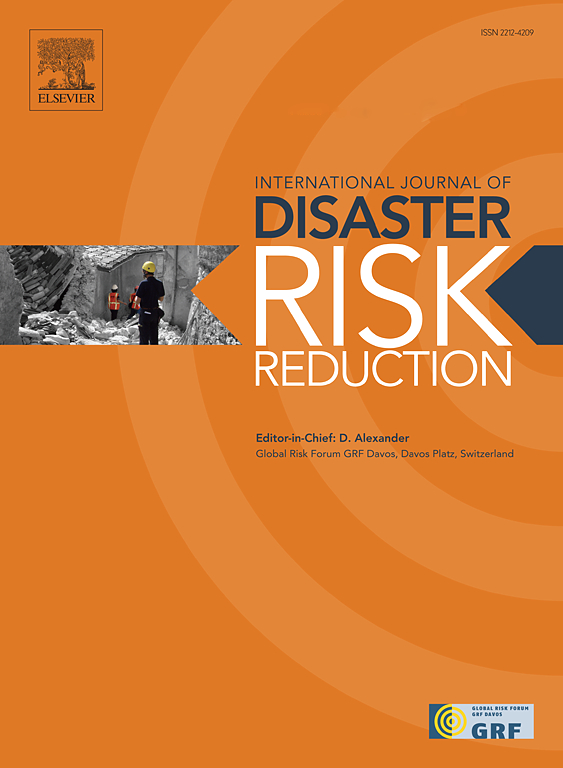Long-term communication of aftershock forecasts: The Canterbury earthquake sequence in New Zealand
IF 4.2
1区 地球科学
Q1 GEOSCIENCES, MULTIDISCIPLINARY
International journal of disaster risk reduction
Pub Date : 2024-10-05
DOI:10.1016/j.ijdrr.2024.104878
引用次数: 0
Abstract
On 14 February 2016, a magnitude (M)5.7 earthquake struck in Christchurch New Zealand (Aotearoa in the Maori language). The shaking caused damage to historic facades, power outages, cliff collapses, rock falls, and liquefaction but no reported injuries or fatalities. This Valentine’s Day earthquake was an aftershock in the Canterbury earthquake sequence (CES), which began on 4 September 2010 with the M7.1 Darfield Earthquake and included the destructive and fatal M6.2 Christchurch aftershock on 22 February 2011. This study, eight months after the Valentine’s Day earthquake and six years after the initiation of the CES, is the first to explore long-term aftershock forecast information and communication needs. The exploratory study also aimed to gather feedback on aftershock scenarios, an alternative form for communicating the forecast.
The qualitative study involved workshops with emergency managers, public health officials, and members of the public in Christchurch. Key findings for long-term communication throughout an earthquake sequence include: 1. divergent earthquake experiences affect aftershock communication response and information needs; 2. understanding aftershock sequence behavior is foundational to sense-making when large aftershocks occur; 3. strategic earthquake sequence updates from the trusted science agency and local agencies could serve as important reminders for earthquake preparedness; 4. communication of aftershock forecast uncertainty could aid with both the credibility of the information and living with uncertainty, and 5. inclusion of impact information and preparedness advice into aftershock forecast scenarios could provide links to actionable information. The paper derives implications for research and practice of long-term communications during an aftershock sequence.
余震预报的长期传播:新西兰坎特伯雷地震序列
2016 年 2 月 14 日,新西兰克赖斯特彻奇(毛利语 Aotearoa)发生 5.7 级地震。摇晃造成了历史建筑外墙受损、停电、悬崖坍塌、岩石坠落和液化,但没有人员伤亡报告。此次情人节地震是坎特伯雷地震序列(CES)中的一次余震,该序列始于 2010 年 9 月 4 日发生的 M7.1 级达尔菲尔德地震,包括 2011 年 2 月 22 日发生的具有破坏性和致命性的 M6.2 级基督城余震。这项研究是在情人节地震发生 8 个月后和 CES 启动 6 年后进行的,是首次探讨长期余震预测信息和通信需求的研究。这项探索性研究还旨在收集有关余震情景的反馈意见,这是预报沟通的另一种形式。定性研究包括与应急管理人员、公共卫生官员和克赖斯特彻奇的公众举行研讨会。在整个地震序列中进行长期沟通的主要发现包括1.不同的地震经历会影响余震传播响应和信息需求;2.了解余震序列行为是大型余震发生时感知决策的基础;3.来自可信赖的科学机构和地方机构的战略性地震序列更新可作为地震防备的重要提醒;4.余震预报不确定性的传播可帮助提高信息的可信度和应对不确定性;5.将影响信息和防备建议纳入余震预报情景可提供可操作信息的链接。本文对余震期间长期通信的研究和实践产生了影响。
本文章由计算机程序翻译,如有差异,请以英文原文为准。
求助全文
约1分钟内获得全文
求助全文
来源期刊

International journal of disaster risk reduction
GEOSCIENCES, MULTIDISCIPLINARYMETEOROLOGY-METEOROLOGY & ATMOSPHERIC SCIENCES
CiteScore
8.70
自引率
18.00%
发文量
688
审稿时长
79 days
期刊介绍:
The International Journal of Disaster Risk Reduction (IJDRR) is the journal for researchers, policymakers and practitioners across diverse disciplines: earth sciences and their implications; environmental sciences; engineering; urban studies; geography; and the social sciences. IJDRR publishes fundamental and applied research, critical reviews, policy papers and case studies with a particular focus on multi-disciplinary research that aims to reduce the impact of natural, technological, social and intentional disasters. IJDRR stimulates exchange of ideas and knowledge transfer on disaster research, mitigation, adaptation, prevention and risk reduction at all geographical scales: local, national and international.
Key topics:-
-multifaceted disaster and cascading disasters
-the development of disaster risk reduction strategies and techniques
-discussion and development of effective warning and educational systems for risk management at all levels
-disasters associated with climate change
-vulnerability analysis and vulnerability trends
-emerging risks
-resilience against disasters.
The journal particularly encourages papers that approach risk from a multi-disciplinary perspective.
 求助内容:
求助内容: 应助结果提醒方式:
应助结果提醒方式:


